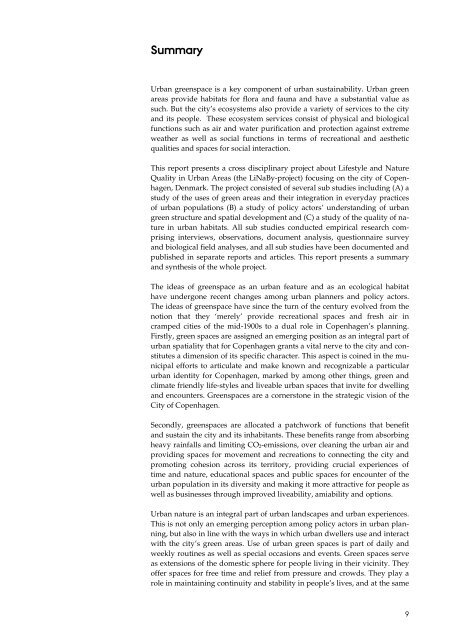Livsstil og naturkvalitet i byrummet - DCE - Nationalt Center for Miljø ...
Livsstil og naturkvalitet i byrummet - DCE - Nationalt Center for Miljø ...
Livsstil og naturkvalitet i byrummet - DCE - Nationalt Center for Miljø ...
Create successful ePaper yourself
Turn your PDF publications into a flip-book with our unique Google optimized e-Paper software.
4VNNBSZ<br />
Urban greenspace is a key component of urban sustainability. Urban green<br />
areas provide habitats <strong>for</strong> flora and fauna and have a substantial value as<br />
such. But the city’s ecosystems also provide a variety of services to the city<br />
and its people. These ecosystem services consist of physical and biol<strong>og</strong>ical<br />
functions such as air and water purification and protection against extreme<br />
weather as well as social functions in terms of recreational and aesthetic<br />
qualities and spaces <strong>for</strong> social interaction.<br />
This report presents a cross disciplinary project about Lifestyle and Nature<br />
Quality in Urban Areas (the LiNaBy-project) focusing on the city of Copenhagen,<br />
Denmark. The project consisted of several sub studies including (A) a<br />
study of the uses of green areas and their integration in everyday practices<br />
of urban populations (B) a study of policy actors’ understanding of urban<br />
green structure and spatial development and (C) a study of the quality of nature<br />
in urban habitats. All sub studies conducted empirical research comprising<br />
interviews, observations, document analysis, questionnaire survey<br />
and biol<strong>og</strong>ical field analyses, and all sub studies have been documented and<br />
published in separate reports and articles. This report presents a summary<br />
and synthesis of the whole project.<br />
The ideas of greenspace as an urban feature and as an ecol<strong>og</strong>ical habitat<br />
have undergone recent changes among urban planners and policy actors.<br />
The ideas of greenspace have since the turn of the century evolved from the<br />
notion that they ‘merely’ provide recreational spaces and fresh air in<br />
cramped cities of the mid-1900s to a dual role in Copenhagen’s planning.<br />
Firstly, green spaces are assigned an emerging position as an integral part of<br />
urban spatiality that <strong>for</strong> Copenhagen grants a vital nerve to the city and constitutes<br />
a dimension of its specific character. This aspect is coined in the municipal<br />
ef<strong>for</strong>ts to articulate and make known and rec<strong>og</strong>nizable a particular<br />
urban identity <strong>for</strong> Copenhagen, marked by among other things, green and<br />
climate friendly life-styles and liveable urban spaces that invite <strong>for</strong> dwelling<br />
and encounters. Greenspaces are a cornerstone in the strategic vision of the<br />
City of Copenhagen.<br />
Secondly, greenspaces are allocated a patchwork of functions that benefit<br />
and sustain the city and its inhabitants. These benefits range from absorbing<br />
heavy rainfalls and limiting CO2-emissions, over cleaning the urban air and<br />
providing spaces <strong>for</strong> movement and recreations to connecting the city and<br />
promoting cohesion across its territory, providing crucial experiences of<br />
time and nature, educational spaces and public spaces <strong>for</strong> encounter of the<br />
urban population in its diversity and making it more attractive <strong>for</strong> people as<br />
well as businesses through improved liveability, amiability and options.<br />
Urban nature is an integral part of urban landscapes and urban experiences.<br />
This is not only an emerging perception among policy actors in urban planning,<br />
but also in line with the ways in which urban dwellers use and interact<br />
with the city’s green areas. Use of urban green spaces is part of daily and<br />
weekly routines as well as special occasions and events. Green spaces serve<br />
as extensions of the domestic sphere <strong>for</strong> people living in their vicinity. They<br />
offer spaces <strong>for</strong> free time and relief from pressure and crowds. They play a<br />
role in maintaining continuity and stability in people’s lives, and at the same

















